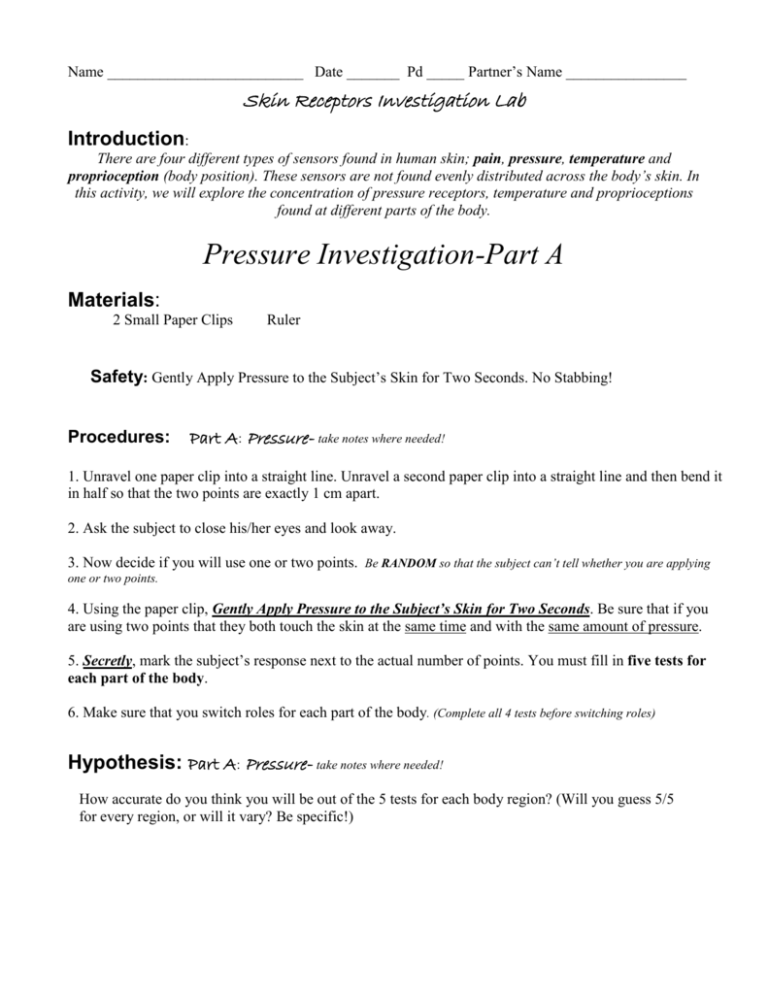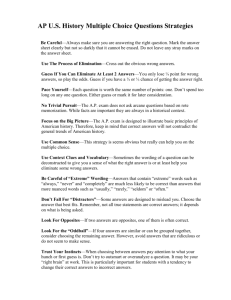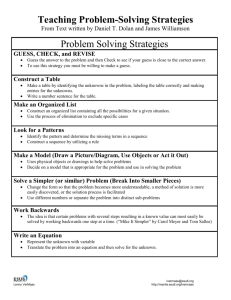Skin Receptors Lab
advertisement

Name __________________________ Date _______ Pd _____ Partner’s Name ________________ Skin Receptors Investigation Lab Introduction: There are four different types of sensors found in human skin; pain, pressure, temperature and proprioception (body position). These sensors are not found evenly distributed across the body’s skin. In this activity, we will explore the concentration of pressure receptors, temperature and proprioceptions found at different parts of the body. Pressure Investigation-Part A Materials: 2 Small Paper Clips Ruler Safety: Gently Apply Pressure to the Subject’s Skin for Two Seconds. No Stabbing! Procedures: Part A: Pressure- take notes where needed! 1. Unravel one paper clip into a straight line. Unravel a second paper clip into a straight line and then bend it in half so that the two points are exactly 1 cm apart. 2. Ask the subject to close his/her eyes and look away. 3. Now decide if you will use one or two points. Be RANDOM so that the subject can’t tell whether you are applying one or two points. 4. Using the paper clip, Gently Apply Pressure to the Subject’s Skin for Two Seconds. Be sure that if you are using two points that they both touch the skin at the same time and with the same amount of pressure. 5. Secretly, mark the subject’s response next to the actual number of points. You must fill in five tests for each part of the body. 6. Make sure that you switch roles for each part of the body. (Complete all 4 tests before switching roles) Hypothesis: Part A: Pressure- take notes where needed! How accurate do you think you will be out of the 5 tests for each body region? (Will you guess 5/5 for every region, or will it vary? Be specific!) Data & Results: Part A: Pressure (Don’t let your partner see this table yet!) Table 1: Subject’s Responses Back of the Hand Trial # Subject’s Guess Actual Number Tip of the Index Finger Subject’s Guess Actual Number Outer Side of the Calf Subject’s Guess Actual Number Back of the Neck Subject’s Guess Actual Number 1 2 3 4 5 Incorrect guesses Data & Results continued: Complete this table when you have finished all of the testing. Table 2: My Responses Trial # Back of the Hand Subject’s Guess 1 2 3 4 5 Incorrect guesses Actual Number Tip of the Index Finger Subject’s Guess Actual Number Outer Side of the Calf Subject’s Guess Actual Number Back of the Neck Subject’s Guess Actual Number Table 3: Class Average Responses Trial # Back of the Hand Tip of the Index Finger Outer Side of the Calf Back of the Neck Correct guesses Incorrect guesses Part A Questions: 1. By looking at the data you have collected, which part of the body is most sensitive to pressure? Which part is the least sensitive? 2. What external factors could affect the sensitivity of a person’s skin? 3. Why do you think it is important for your extremities (hands, fingers, and feet) to have a greater concentration of sensors than the trunk of the body? 4. Do you think the concentration of pressure receptors in the fingers and legs would be related to the concentration of other receptors such as pain and temperature? Explain your answer! Temperature Investigation- Part B Materials: Ice Water Hot water Q-tips/Droppers Procedures: 1. Fill one beaker with very hot water (not boiling!) and another with ice water and obtain a clean dropper. 2. Drop 1 drop of either hot or cold water on the region of the body from the table below. Indicate the seconds it takes the subject to identify the temperature and if it was done so correctly. 3. For each region drop 1 drop 3 times (do so randomly, switching between hot and cold; for example first drop cold, second drop hot, third drop hot, in ANY pattern) 4. Record data in the table below. Once subject has completed all body regions, switch and have the same areas tested on second subject (yourself). 5. Calculate the average time (in seconds) it takes for each body part (using class data) to identify temperature. Hypothesis: Part B: Temperature- take notes where needed! How accurate do you think you will be out of the tests for each body region? (Will you guess the temperature accurately and how long (in seconds) will it take you? Be SPECIFIC. Data & Results: Part B: Temperature (Don’t let your partner see this table yet!) Table 4: Subject’s Temperature Sensitivity Back of the Hand Trial # Subject’s Guess Tip of the Index Finger Actual Temp. Subject’s Guess Outer Side of the Calf Actual Number Subject’s Guess Actual Number Back of the Neck Subject’s Guess Actual Number 1 2 3 3 2 1 3 2 1 3 2 1 3 2 1 Time (sec) Table 5: My Temperature Sensitivity Back of the Hand Trial # Subject’s Guess Tip of the Index Finger Actual Temp. Subject’s Guess Outer Side of the Calf Actual Number Subject’s Guess Actual Number Back of the Neck Subject’s Guess Actual Number 1 2 3 3 2 1 3 2 1 3 2 1 3 2 1 Time (sec) Table 6: Class Average Temperature Sensitivity Back of the Hand Trial # Tip of the Index Finger Outer Side of the Calf Back of the Neck Correct guesses Incorrect guesses AVG Time (sec) Part B Questions: 1. By looking at the data you have collected, which part of the body is most sensitive to temperature? Which part is the least sensitive? 2. What external factors could affect the sensitivity of a person’s skin to temperature? 3. Why do you think it is important for your extremities (hands, fingers, feet) to have a greater concentration of sensors than the trunk of the body? 4. Do you think the concentration of temperature receptors in the fingers and legs would be related to the concentration of other receptors such as pain and pressure? Explain your answer! 5. Explain why humans have adapted sensitivity to various temperatures in different parts of the body, over time. (What caused the trait to evolve… why is it beneficial?) Proprioception Investigation - Part C Materials: Masking tape Blindfold Procedures: 1. Ask the subject to close his or her eyes and extend their arms out at their sides. 2. Have them hold that position (eyes closed) for 10 seconds. 3. After 10 seconds has passed, ask subject to keep eyes shut and touch their nose with their right index finger. 4. Ask them to put their right hand back at their side and wait 5 seconds (eyes still shut.) 5. After 5 seconds has passed, ask subject to keep eyes shut and touch their nose with their left index finger. 6. Record data in table below. (repeat this 3 times, take the average of all 3) 7. Subject can open their eyes; test being completed. 8. Move subject to the back of the room at the starting point of tape on the floor. 9. Inform subject they are to walk in a straight line, on the tape, to the end point with their eyes shut. 10. Have subject complete line walk, giving them no directions. Once subject has passed finish point ask them to open their eyes, turn around, stand back onto line (if wandered off), shut their eyes and walk back to start on the line 11. Record data in table below. Hypothesis: Part C: Proprioception How accurate do you think you will be for both tests? Be Specific! Data & Results: Part C: Proprioception (Don’t let your partner see this table yet!) Table 7: Finger to nose Subject Yourself Right Left Right Left Observations ? (straight, wobbled, halfway, etc) Touched Missed Touched Missed Touched Missed Class Average # Touched Missed (nothing here) Table 8: Walking Straight Subject Walk Down Yourself Walk Back Walk Down Walk Back Observations (straight, wobbled, off line halfway, etc) Time (seconds) Class Average time (nothing here) Questions: 1. By looking at the data you have collected, compare the accuracy to the hand that was being tested for the class average. Does this relate to someone being “right handed, or left handed?” 2. What is the importance of this sense? College Prep: You are to write a 2 page conclusion (typed, double spaced) telling me how the senses tested are important human adaptations. Give examples of different human populations (based on where they live; in different biomes). You MUST have a citation page! Honors- A formal lab report will be made from this data. Be NEAT and organized when collecting your data.







